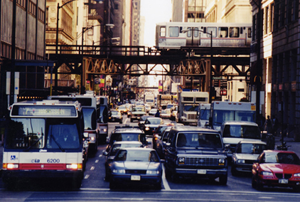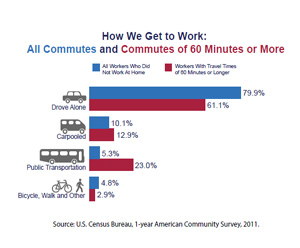- Home
- News
- Features
- Topics
- Labor
- Management
- Opinions/Blogs
- Tools & Resources
Mega-Commuters: 600,000 Workers Have 90-Minute Or More Commute
By ROBERT SCALLY— I was once among an elite corps of mega-commuters.
As defined by the U.S. Census Bureau, mega-commuters are about 600,000 full-time American workers who commute at least 90 minutes and 50 miles to get to work. About 8.1% of U.S. workers have commutes of 60 minutes or longer, according to a new Census Bureau report.
An select cadre of road warriors had “mega-commutes” of at least 90 minutes and at least 50 miles each way.

The Census Bureau’s 2006-2010 American Community Survey found that 586,805 full-time workers were mega-commuters.
I was indeed part of this elite group since the Census Bureau’s data coincides almost exactly with my last mega-commuter stint.
The Census Bureau’s 2006-2010 American Community Survey found that 586,805 full-time workers were mega-commuters. I was one of the one in 122 of full-time workers who were mega-commuters.
Becoming a mega-commuter was my own fault. I willingly, though reluctantly, accepted employment at distance from my home. Decent-paying work in my field was, and is, scarce in San Diego County. And I made mega-commutes not once but twice.
My first mega-commute round trip was about 170 miles per day and lasted for two years during the mid-1990s. The second was from 2006-2010.
In both instances I drove from my home in northern San Diego County, Calif., to central Orange County, Calif., near the site of John Wayne International Airport.
Mega-Commuters’ Round Trip
During the second of my two stints as a southern California mega-commuter my round trip to work was about 164 miles, depending on the route taken.
Nearly all of the commute was freeway driving.  If I was lucky, I was in the car for about 90 minutes each way.
If I was lucky, I was in the car for about 90 minutes each way.
The average one-way daily commute for U.S. workers country is 25.5 minutes, according to the Census Bureau. White not mega-commuters, a full 10.8 million workers commute an hour each way.
As a mega-commuter, I drive along Interstates 15 and 5, though the Camp Pendleton Marine Corps base and past the San Onofre nuclear power plant.
The trip ranged from horrifically dangerous in the rain to sublime during good weather along the part of the commute offered a view of the Pacific Ocean.
As it turns out, my fellow mega-commuters were a lot like me: male, older, married, making a higher salary, with a stay-at-home spouse, the Census Bureau found. (That last part was not true in my case, as my spouse worked full-time, however.)
Mega-commuters are mostly men: 75.4% male and 24.6% female. Mega-commuters are more likely to depart for work before 6 am. I was up before dawn and on the road no later than 5:30 am to beat the traffic.
Limited Rail Options For Southern California Mega-Commuters
In theory I could have gotten to by rail, using a combination of Amtrak, Metrolink, and San Diego’s Coaster light rail. But the train’s schedule would have doubled the amount of time I would spend in transit. I would still have to drive to train station and pay to park on top the train fare cost.
Even with gas prices above $3.50 a gallon, the train wasn’t going my way.
As one might expect, many of America’s mega-commuters live in the northeast and great many use public transit.
Workers in New York state have the most long commutes at 16.2%, followed by Maryland and New Jersey at 14.8% and 14.6%, respectively. Among workers with commutes of 60 minutes or more, 23% use public transit.
That compares with 5.3% public transit for all workers. Nearly 12% of workers with long commutes travel by rail.Other forms of public transportation accounted for 11.2%.
“The average travel time for workers who commute by public transportation is higher than that of workers who use other modes,” said the report’s author, Census Bureau statistician Brian McKenzie. “For some workers, using transit is a necessity, but others simply choose a longer travel time over sitting in traffic.”
Mega-Commuters Carpool
Some mega-commuters have managed to carpool, since 61% of workers with long commutes drive to work alone. Overall, 80% of car-bound commuters drive to work solo.
A year into my second mega-commuting stint my employer hired a person I not only knew, but who lived nearby. Carpooling, sharing the drive, helped us both a great deal.
Spending some three hours a day together it was good thing we shared a love of a wide variety of music, NPR and beer. We became good friends.
A back injury sustained during a drive home from work during my 1990s stint as a mega-commuter eventually ended my commuting days forever, leaving me disabled with surgically fused vertebrae.
In both of my mega-commuting experiences my employers wouldn’t sanction working from home despite the fact the jobs could, and sometime were, easily done via telecommuting.
My back condition worsened the more commuting I did. I had surgery. Eventually, I was laid off when my employer relocated to the Midwest. Subsequent back surgery ended my commuting days forever. It may have been mega, but I don’t miss my long distance commute.
Related stories:
Major Commuting Patterns Of American Workers
Other reading:
Mega Commuters If you spend 90 minutes or more getting to work every day, then this blog is about you. Please Subscribe to WWOW’s pasts by email: [subscribe2]
List your business in the premium web directory for free This website is listed under Human Resources Directory





